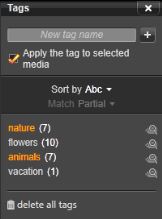Tags
The Library is capable of handling a great number of asset files, sometimes far more in even a single folder than can be viewed conveniently. The Browser therefore provides a number of methods of winnowing out irrelevant assets from the display.
One method of streamlining the display of assets in the Browser is filtering by tags. A tag is simply a word or short phrase that you think would be useful as a search term. It is up to you whether you assign tags to your media, but if you do, they provide a powerful way of selecting assets to display.
Management of tags, and filtering by tags, are handled in a panel that appears when the Tags button at the top of the Library is clicked. The panel can also be invoked by choosing Apply tag > Create new tag from any asset’s context menu.

The tags panel, with existing tags listed alphabetically.
At the top of the tags panel is a text box for entering new tag names. The panel also lists all the tags you have defined so far, lets you delete or rename them, and lets you choose which assets you want displayed in the Library.
To create a new tag, click in the text box at the top of the tags panel and type in your tag. Select the media that you want to tag, make sure the Apply the tag to selected media box is checked, and click the Create new tag button beside the text box. There is no limit to the number of tags you can create. However, if you try to apply a name that isn’t new, you will be notified that the name already exists, and it will not be added to the selected media.
To apply an existing tag to all currently-selected assets in the Browser, click the tag name. Selecting multiple assets to tag makes the process much more efficient than if you could tag only one item at a time.

Hovering over a tag reveals the Rename and Delete buttons. Clicking the tag itself applies it to any currently-selected assets.
Hovering the mouse over a tag reveals the controls for renaming or deleting the tag. To rename, click the Rename icon, type in the new name, and press Enter. Click the Trashcan icon to delete the tag. To delete all tags at once, use the Delete all tags button at the bottom of the panel. If you are deleting a tag that is in use, you will be given a chance to back out of the operation.
In the middle of the tags panel is the Sort by dropdown, offering just two choices: ‘Abc’, in which the tags are sorted alphabetically, or ‘Relevance’, which sorts them in descending order of their popularity in the set of assets currently on display. Under the second choice, you will see the tags being resorted each time one is checked or unchecked.
Beside each tag name listed in the panel is a Filter icon that you can use to narrow the set of items displayed in the Browser. As you check and uncheck the tags, the view updates automatically.
The exact effect of your selections depends on another control, the Match dropdown just above the tags. The list provides three options.
None displays only assets that have none of your check-marked tags. In a tagged set of animal photos, checking both the ‘dog’ and ‘cat’ tags, then selecting ‘None’, should hide most of the pet pictures.
Partial selects assets with any of your tags, which happens to be exactly those hidden by ‘No match’. If you leave ‘dog’ and ‘cat’ checked, but switch to ‘Partial’, all the dogs and cats will be displayed, including the handful of photos in which both animals appear. Photos with neither tag will be hidden.
Full selects only the assets that have all your tags. Now with the same boxes checked you should see only those photos in which at least one cat and one dog appear. Notice that under ‘Partial’ you will see more assets displayed as you check more tags, but with ‘Full’ you will see fewer.
When tags are set to filter the contents of the Library, an orange bar at the top of the Browser lists which tags are being used. To turn off filtering by an individual tag, bring up the tag panel and uncheck the tag’s Filter icon. To turn off all filtering at once, click the x button at the right hand end of the orange bar.
The art of tagging
There is no prescribed way of using tags. The best way to use them – if you do – is the way that works best for you. Consistency is important, however. The more faithful and systematic you are about assigning tags to your media, the more useful they will be.
Since the idea is to locate an asset quickly when you need it, tags should be chosen to work well as search terms. With family photos, your tags might include the names of the people in each shot. For vacation video scenes, tags naming the locations visited would probably be useful.
Video graphic terms (‘two-shot’, ‘silhouette’, ‘exterior’) can also serve as good tags by making it easier to find assets that fulfill particular structural or creative requirements.